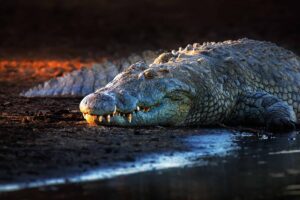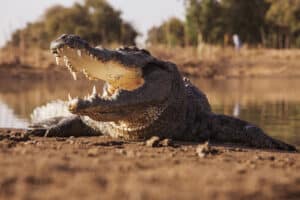For years, tales of big saltwater crocodiles (salties) swimming far out to sea have persisted. But, until 2010, no one had ever attempted to study the oceangoing habits of salties to determine whether these stories were fact or fiction. Then, with a study partially funded by the late Steve Irwin (known as The Crocodile Hunter), researchers finally tackled the big question. Namely, whether or not crocodiles can “surf.” And, if they can, just how far they can go.
Here, we’ll learn more about the incredible reptiles that are saltwater crocodiles. We’ll find out what they eat, where they live, and what they look like. Then, we’ll take a look at the 2010 study and find out whether or not crocodiles really can surf ocean currents.
All About Saltwater Crocodiles

The largest living reptile documented by science, the saltwater crocodile ambushes its prey before drowning it or swallowing it whole.
©Pius Rino Pungkiawan/Shutterstock.com
Saltwater crocodiles are the largest reptiles on the planet. The largest males can top 20 feet, yet, these fearsome predators provide excellent, attentive care to their hatchlings. Salties famously live in northern Australia, but would you believe that they also live throughout much of the South Pacific? That’s right. Crocs have found a way to cross oceans in search of new places to live. Let’s take a look at some of the things that make salties so special.
Where Do Saltwater Crocodiles Live?
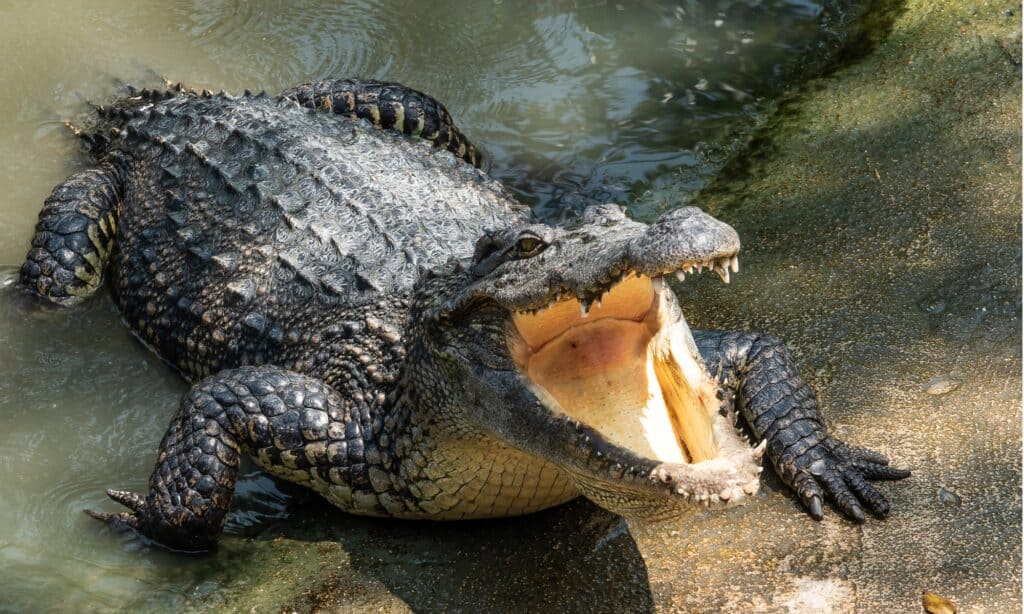
Saltwater crocodiles are capable of growing to 20 feet and weighing over 2,000 pounds.
©iStock.com/AppleZoomZoom
Saltwater crocodiles are the largest crocodilians alive today. Crocodilians include all crocodiles (including Nile crocodiles) as well as alligators, caimans, and gharials. Salties are found along the northern coast of Australia and as far west as eastern India and Sri Lanka. They’ve colonized all the islands in the Philippine, Solomon, and Sunda island chains. Salties can also be found as far away as Fiji, Vanuatu, Thailand, and southern China.
Despite their broad range, saltwater crocodiles live in very specific types of environments. Crocodiles can “surf,” but they can’t live in mountains, plains, or even anywhere too far from water. Instead, these apex predators spend their days swimming in mangrove swamps, rivers, and estuaries. Saltwater crocodiles get their name from their love of brackish (low salinity) water.

Saltwater crocodiles are the largest of the crocodiles alive today.
©Johan Larson/Shutterstock.com
Size and Appearance
Saltwater crocodiles typically grow to about 20 feet long, but they can reach even greater lengths. The largest saltie ever reliably measured was over 23 feet long! The largest saltwater crocodiles can weigh over 2,000 pounds. However, because of rampant hunting until the enaction of protections in 1970, there are few truly monstrous salties left.
Like all crocodilians, saltwater crocodiles have heavily armored bodies topped with large heads. They have short legs, heavy bodies, and long, powerful tails. Salties spend most of their time in a ‘sit and wait’ ambush. Despite this, crocodiles can “surf” using the river and oceanic currents. Their thick skin and hydrodynamic bodies help them to reach distant islands.

Saltwater crocodiles can reach 20 feet long.
©sushil kumudini chikane/Shutterstock.com
Predators
In spite of their status as the largest crocodilians and apex predators, saltwater crocs don’t start out life invincible or at the very summit of the food chain. As a matter of fact, youngsters are susceptible to a large number of foes which consider them a tasty morsel. Included on that list are blue herons, egrets, birds of prey such as eagles, large felines such as tigers and leopards, monitor lizards, and even other fish.
With so many predators ready and waiting the chances of young salties making it to full adulthood are pretty slim: only 1% of hatchlings will ever get to attain full size.
Lifespan
Crocodiles typically live for 40 to 70 years in the wild, though some have been known to live longer. They are apex predators and therefore do not have many natural enemies. However, they face a number of threats from humans. One of these is habitat destruction due to land conversion for agricultural or urban development, which reduces their available habitats and resources.
Additionally, they are hunted by people for their meat and skin, which has led to population declines in certain areas where crocodile hunting is common. The illegal trade of crocodiles also poses a threat, as this often results in the capture of juveniles or eggs that can disrupt breeding populations. Finally, climate change has caused sea level rise, which threatens coastal crocodile habitats with increased erosion and flooding.
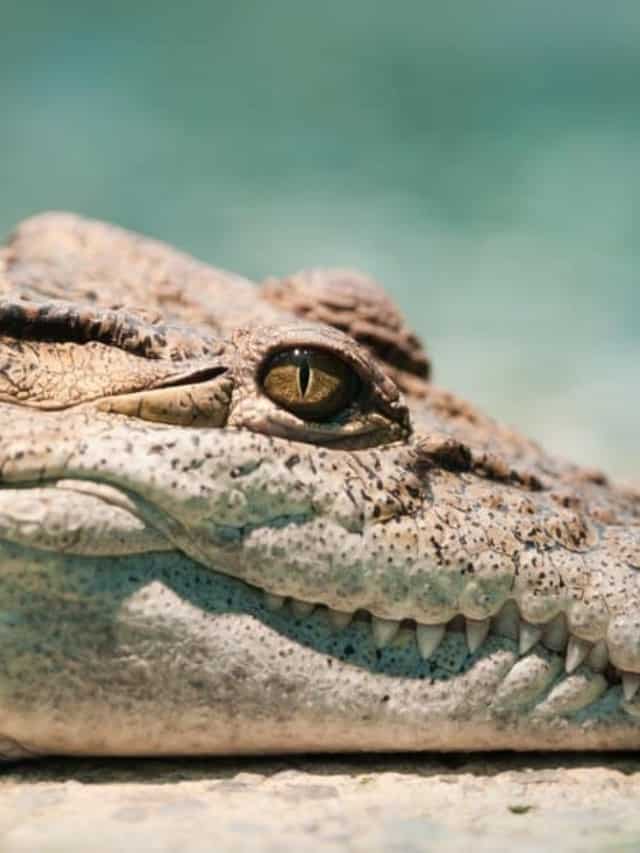
Crocodiles can live for up to 70 years.
©Peter Wey/Shutterstock.com
Diet and Behavior
Saltwater crocodiles hatch from eggs. At birth, baby crocodiles are extremely vulnerable. Luckily, they have their mothers to protect them. Small salties eat insects, rodents, small fish, birds, amphibians, and turtles. As they grow, they can kill and eat bigger game. Adult crocodiles are at the top of the food chain; they eat deer, wild boar, monkeys, gibbons, water buffalo, fish, and even dingoes and kangaroos.
Saltwater crocodiles have one of the strongest recorded bite forces on Earth. Their heads are specially designed to clamp onto prey and never let go. Because crocs can’t chew, they rely on their teeth and jaw strength to hold on to even the largest of prey.
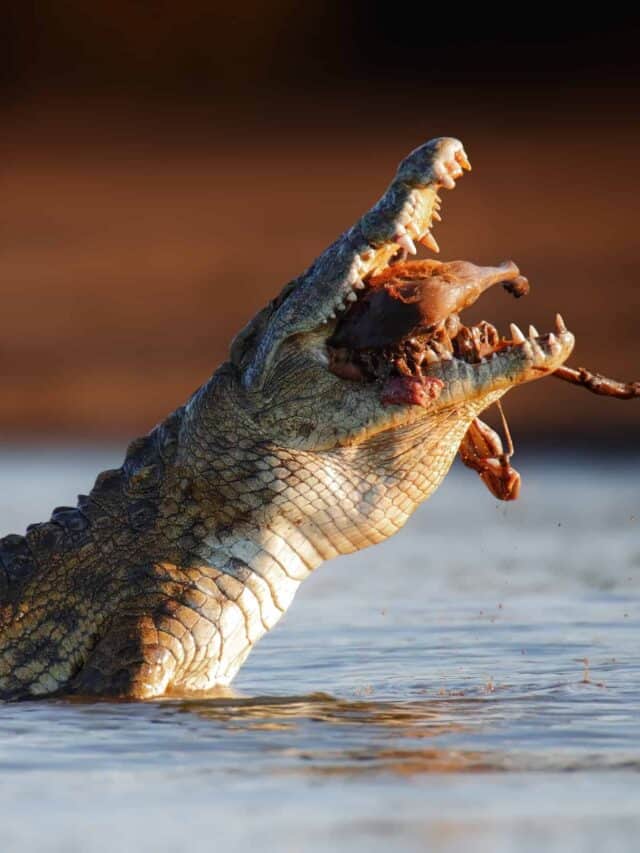
Crocodiles are ambush predators and eat a wide variety of foods.
©Mari Swanepoel/Shutterstock.com
Can Crocodiles “Surf”?
So, after decades of stories of crocodiles swimming far out to sea, a group of researchers finally decided to test the veracity of the claims. Using traps and anesthetic, they implanted a group of adult saltwater crocodiles with tracking devices. Over the course of a year, they recorded all the crocs’ movements.
What they found was astonishing. The researchers discovered that saltwater crocodiles do indeed travel great distances in open ocean water to reach distant islands. They showed that crocodiles could “surf”; one saltie even surfed over 366 miles in 25 days. To accomplish this, crocodiles only swim when the tide is with them. When the tide is against them, they dive deeper or rest until the tide turns.

Why Do Crocodiles “Surf”?
So, crocodiles can “surf,” but why do they surf? Previous to the study, scientists had long wondered how saltwater crocodiles could have such a broad range divided by seemingly untraversable deep ocean waters. Typically, when a group of animals from one species moves to a new island home, they speciate, becoming an entirely new species due to genetic isolation.
But this isn’t the case with crocodiles. Now that scientists know that crocodiles can “surf” long distances, they have an explanation for this lack of speciation. Their conclusion is that crocodiles who have learned to “surf” have been able to colonize a greater range, which makes them genetically more successful. So, part of the saltie’s secret to being successful is their ability to travel great distances using ocean and riverine currents.
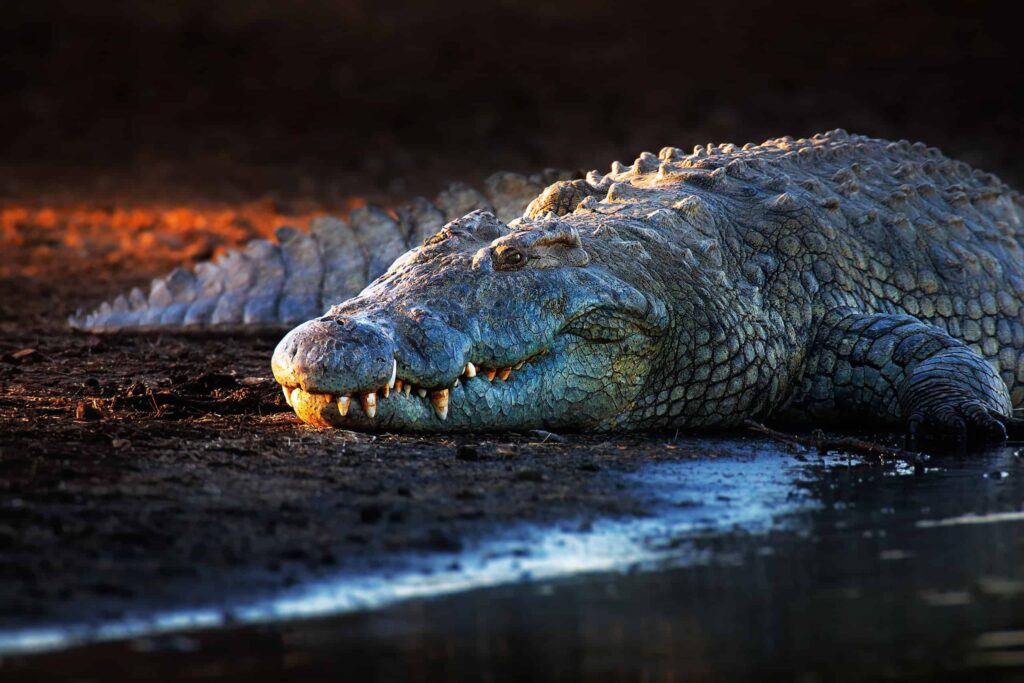
Crocodiles are able to travel long distances using ocean and river currents.
©Johan Swanepoel/Shutterstock.com
Is It Normal For Crocodiles To Go in Salt Water?
It might seem strange, but saltwater crocodiles can indeed survive in full salinity salt water. They need fresh water to drink, but when they’re out to sea, crocs can actually go a long time without “drinking.” And, because they have low permeability skin, they don’t soak in the saltwater the way other animals attempting the same journey would. Additionally, crocodiles can go over a year without feeding, so getting hungry on a long journey isn’t an issue.
Alligator versus Crocodile
The most obvious difference between an alligator and a crocodile is their physical appearance. Alligators have wide, rounded snouts, while crocodiles have pointed, V-shaped ones. Alligators also tend to be darker in color, with more black than crocodiles which are lighter in color and usually feature visible tan or grey stripes on the back of their body.
Furthermore, alligators generally live only in freshwater habitats such as lakes and rivers, while crocodiles can inhabit both fresh and saltwater environments such as swamps, estuaries, lagoons, and mangrove forests.
Another key difference is that when an alligator closes its mouth, its teeth remain hidden, while a crocodile’s teeth are always showing even when its mouth is closed. Finally, another way to tell them apart is by looking at the size. Alligators typically reach lengths of up to 12 feet long, whereas some species of crocodiles can grow up to 18 feet long!
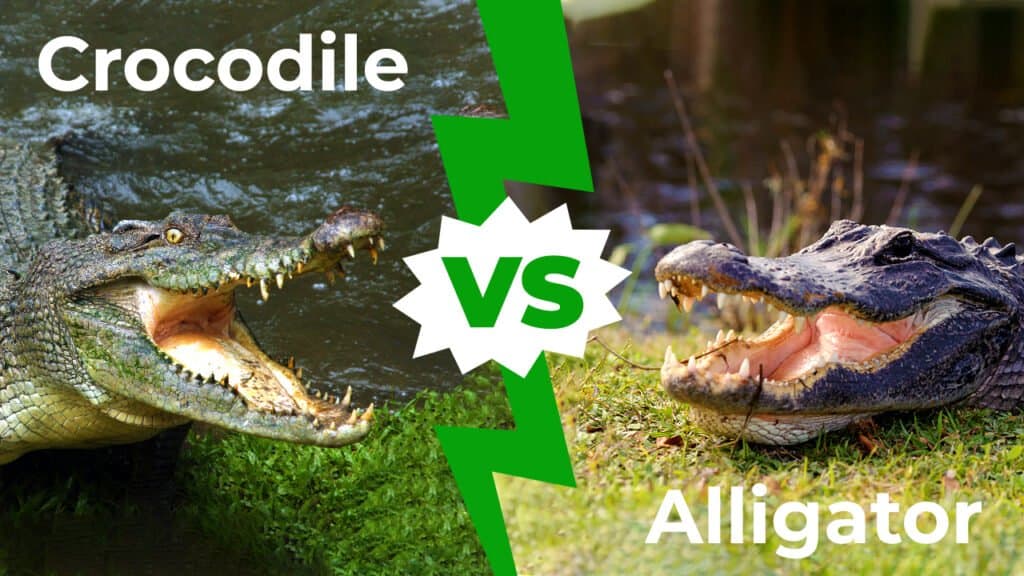
Are Saltwater Crocodiles Endangered?
Thanks to conservation efforts that have been ongoing since the 1970s, saltwater crocodiles are no longer in danger of extinction. Crocodiles can “surf”, but they can also be dangerous to humans. Part of the saltie management strategy is to keep large adults away from urban populations. Unfortunately, there are currently over ten species of crocodilian listed as Critically Endangered. Only extreme human effort will keep these species from going extinct in the upcoming decades.
The photo featured at the top of this post is © PomInOz/Shutterstock.com
Sources
- , Available here: http://www.iucncsg.org/pages/Conservation-Status.html
- , Available here: https://www.britannica.com/animal/crocodile-order/Natural-history
- , Available here: https://www.nature.com/articles/news.2010.282
- , Available here: https://besjournals.onlinelibrary.wiley.com/doi/10.1111/j.1365-2656.2010.01709.x
Thank you for reading! Have some feedback for us? Contact the AZ Animals editorial team.




